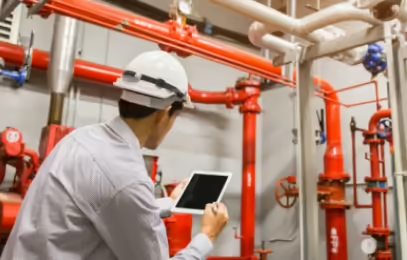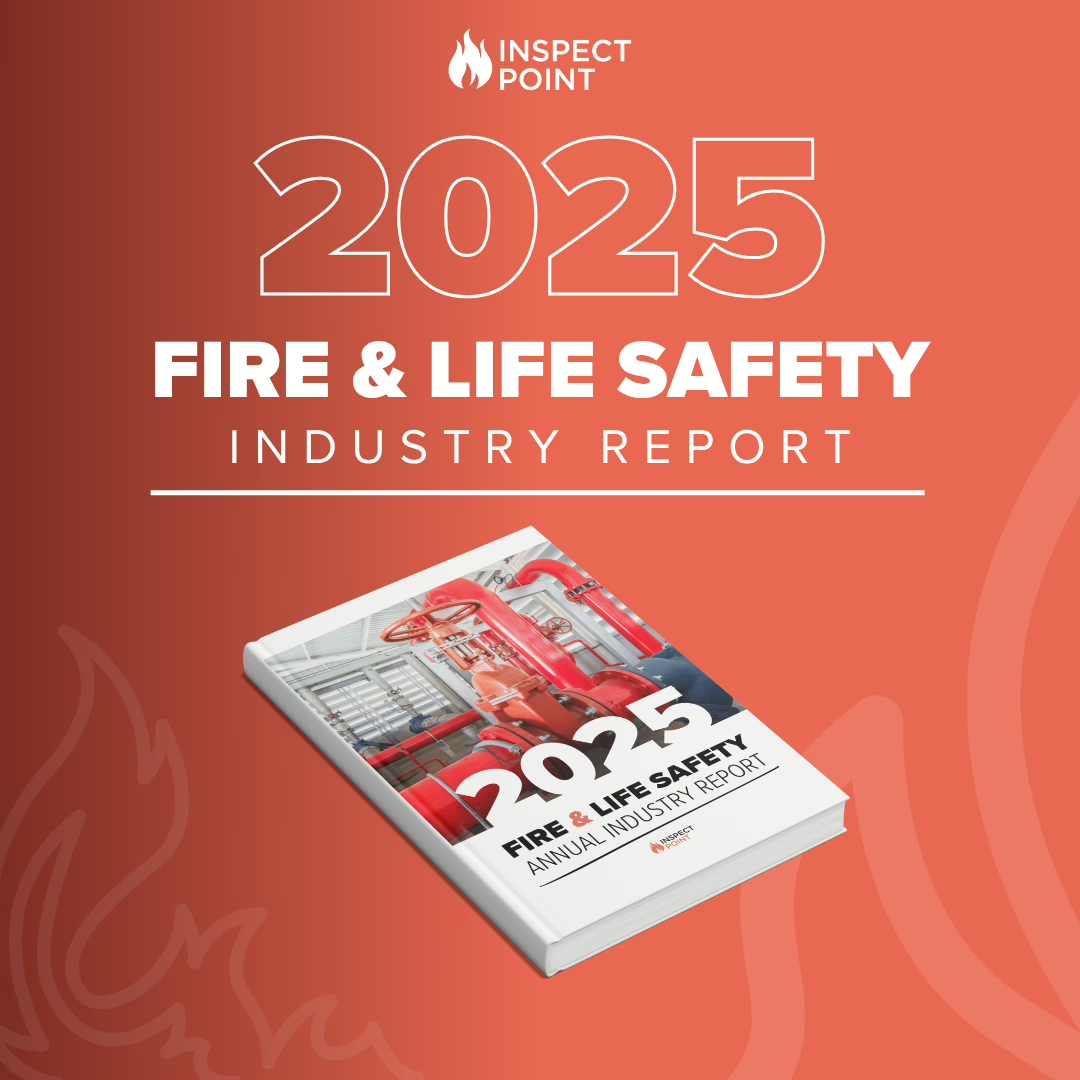
Understanding Fire Protection and the Role of Fire Protection Systems
If you take all the buildings, roads, and other structures built across the United States between 2001 and 2019 and put them together, the area would cover more than 14,000 square miles. What’s that in perspective? According to the Washington Post, those new developments are more than five times the size of Delaware.
As development sprawls beyond urban areas, we’re starting to see new challenges for fire departments that highlight just how important fire protection and proactive fire prevention are. The question is: Can the fire protection industry keep pace with the growth?
While fire protection and prevention strategies are evolving along with development, structures are still burning.
In fact, every 23 seconds, a fire department in the United States responds to a fire, with structure fires sparking every 65 seconds.
In 2021 alone, local fire departments responded to more than 1.3 million fires that caused nearly 4,000 deaths and injured nearly 15,000 people (source: NFPA). These fires also resulted in almost $16 billion in property damage.
While a majority of these fires happened in homes, nonresidential fires are on the rise. According to the U.S. Fire Administration (USFA), from 2012 to 2021, nonresidential fires increased by 20%, exceeding 116,000 in 2021.
If you’re a fire industry professional, it’s important to help your customers understand what fire protection is and why every home, business, and other structure should have a fire protection system supported by a fire prevention plan. Many might think of the traditional, “stop, drop, and roll,” but for larger structures, like business offices, warehouses, and other facilities, there are much more in-depth strategies to employ.
Fire Stages and Classifications
There are three elements to every fire that, when combined, create what’s known as the fire triangle.
Flammable Material + Fuel + Oxygen = Fire Ignition
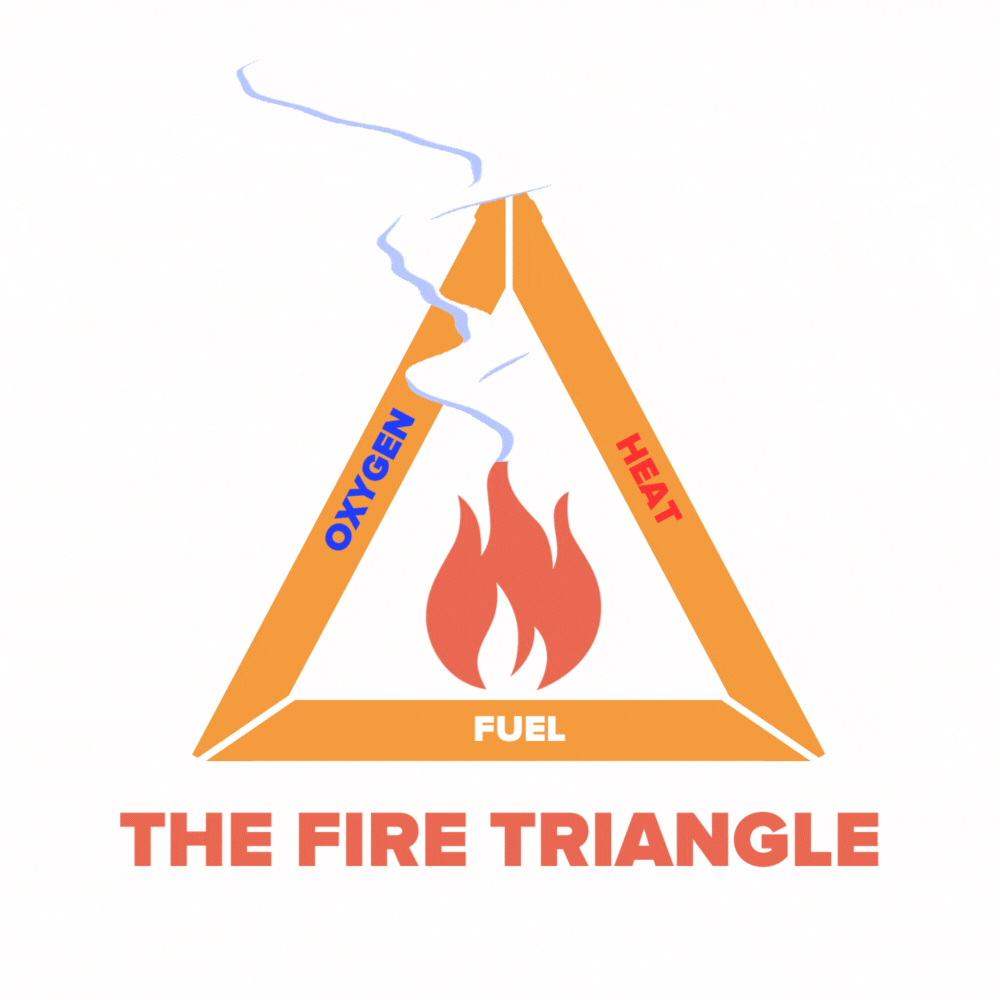
There are five primary classifications of fire based on fuel type:
- Class A: Combustible materials like cloth, paper, wood, plastics, etc.
- Class B: Flammable liquids that burn at room temperature and combustible liquids that catch fire with heat.
- Class C: Class A or B fuels involving energized electric devices that make it dangerous to attempt to extinguish the fire with water. Class C fires require specific methods to extinguish–for example, a dry chemical agent.
- Class D: Combustible metals.
- Class K: Fires in cooking appliances with combustible cooking materials like fats and oils.
Most fires move through a four-stage process: ignition, growth, full development, and burnout. So, what is fire protection? Fire protection is the process used to contain and extinguish these fires, pushing them to burnout at a faster pace, either by cooling them, robbing them of oxygen or fuel, or breaking down their chemical reaction.
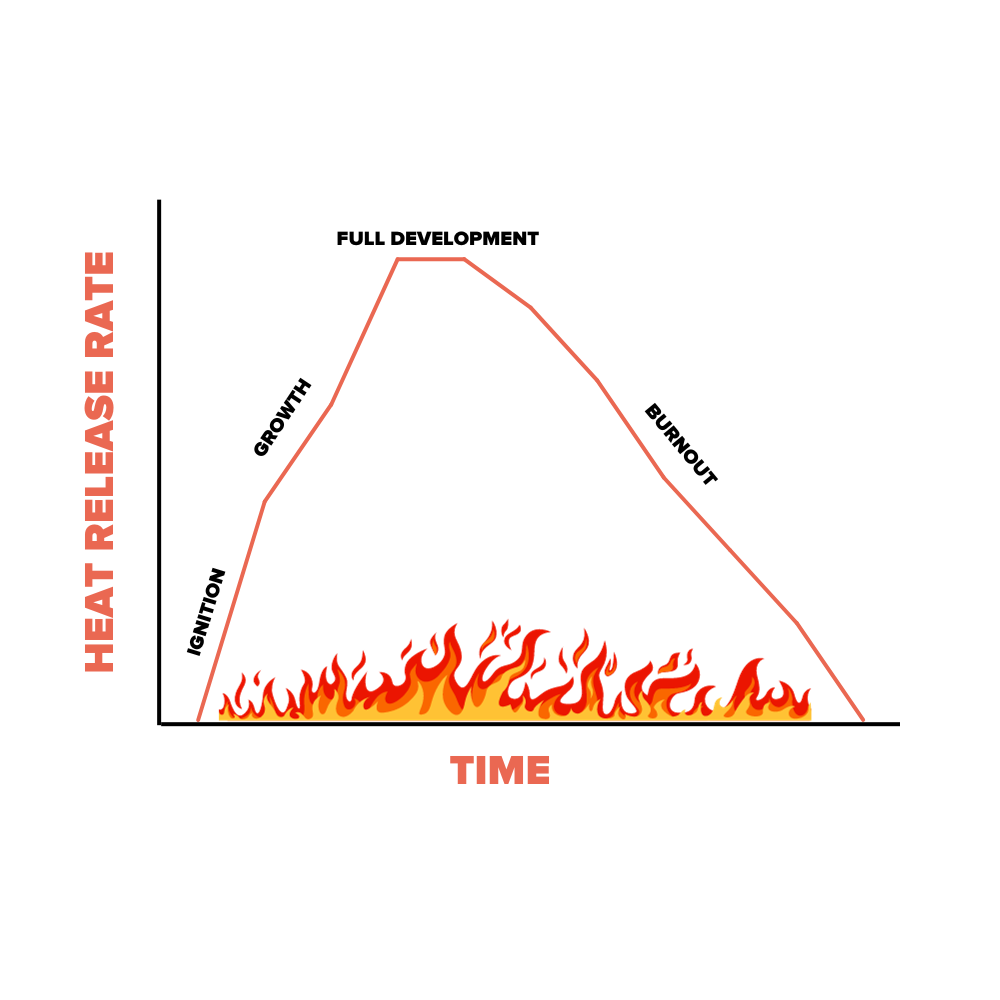
What Is Fire Protection?
NFPA defines fire protection as “all measures taken to reduce the burden of fire on the quality of life.” In simple terms, fire protection is about implementing measures and strategies that stop the spread and intensity of a fire, while also reducing its impact and damage.
Fire protection measures can include:
- Fire safety plans and training
- Fire prevention systems
- Fire suppression systems
- Devices such as alarms, smoke detectors, and fire extinguishers
- Evacuation routes and plans
- Fire drills
- Developing emergency procedures and ensuring employee awareness (for example, fire drills)
Fire protection encompasses:
- Assessing potential fire risk and impact (AKA a fire risk assessment): Such an assessment includes identifying potential fire hazards, understanding who and what is at risk, understanding potential impact, mitigating and eliminating fire risk, and ongoing fire risk management
- Employing passive fire protection measures to contain or limit a fire: Passive fire protection measures include facility design, fireproofing strategies, training, education, and equipment installation and maintenance.
- Employing active fire protection measures: This includes firefighting systems such as fire detection and suppression systems.
Implementing Fire Protection Best Practices
In most cases, fire protection should be addressed across three core areas:
- The planning and construction of a structure, or the retrofitting of a structure
- All systems employed for fire protection
- Policies, procedures, plans, and strategies
Many individuals might think of fire protection in terms of installing devices such as smoke alarms, fire extinguishers, and sprinkler systems, but there is an often overlooked, critical piece of the fire protection puzzle: equipment inspection and maintenance.
When teams don’t regularly inspect or properly maintain fire safety equipment, it decreases their effectiveness and increases the risk of fire. That’s why it’s important to ensure all your fire safety equipment is in good working order at all times so that each device performs as designed. Failing to do so could have serious consequences and increase the potential for fire to spread and cause damage.
It’s not enough to simply place fire extinguishers and other devices throughout a building. These extinguishers (and other fire safety equipment) should be routinely evaluated and maintained. Fire extinguishers should be addressed at a minimum of once every two years, while other fire protection systems require more routine checks–as often as weekly or monthly.
Properly inspecting and maintaining fire protection equipment is not only a best practice, but, in many cases, is a requirement as part of local, regional, state, or industry fire code regulations. Failure to ensure these devices operate as they should could result in costly fines or other penalties. You may even be risking facility closure.
Beyond that, ensuring fire protection equipment functions properly is a matter of life or death. If done properly, fire protection systems and processes save lives and limit damage. If you don’t keep up with your equipment and ensure effective functionality, you may be putting lives and property at great risk.
Some key steps in fire safety maintenance are:
- Maintaining signage and lighting for emergency and exit routes
- Routinely servicing equipment
- Having a certified fire inspector check all equipment, processes, plans, and facilities
- Ensuring suppression devices such as fire extinguishers, sprinklers, etc. function properly
- Ensuring exit routes are the quickest and safest departure points and that they are clear of debris or blockages
Why Is Fire Protection Important?
Fire protection is important because it helps ensure the safety of people and structures. It can decrease fire spread and damage, reduce the likelihood of injuries, and provide safe evacuation routes.
While the most important component of fire protection is saving lives, it also plays a significant role in protecting businesses and other organizations from significant structure and asset damage, as well as financial and other losses from interrupted business operations. Fire protection also has important implications for protecting the environment from dangerous chemical spills or other damage.
Ensuring fire protection systems are functioning properly is a matter of life or death.
While some might shrug off the role of fire protection, thinking, “We’ve never had a fire, why should we?” The reality is, even with the best-laid plans, fires still happen, which makes fire protection increasingly important. It’s a practice that shouldn’t be overlooked.
For fire industry professionals, fire protection is more than preventing fires. It’s about protecting lives, facilities, and in some cases, the economic wellbeing of a local business or community. In many instances, fire protection companies work with local fire departments to keep their jurisdictions safe. Think of fire protection as a shield that protects everyone and everything from the devastating effects of a fire. That includes early-warning devices, fire suppression, fire-resistant and fire-proof construction, education, training, planning, processes, and more.
What Is a Fire Risk Assessment?
A fire risk assessment is similar to other risk assessment, but, obviously, its focus is specifically on fire scenarios, probability, impact, and consequences. Other interchangeable terms are fire risk analysis, fire hazard assessment, and fire hazard analysis.
A fire risk assessment is a proactive approach and an important foundation to build effective fire protection strategies. An assessment helps organizations understand hazards so they can create customized fire safety plans. It also helps with early hazard detection for fire risk reduction and response time improvement. Not only will a fire risk assessment help protect lives and property, if conducted and documented properly, it could also help reduce liability in case of fire, damage, injuries, or deaths.
Based on NFPA 551: Guide for the Evaluation of Fire Risk Assessments, every fire risk assessment should take into account the level of risk in a structure, ways to lower the risk, and ways to address acceptable levels of risk. The goal is to assess fire risks and find ways to make a structure safer.
Depending on the type of business or organization, fire risk assessments are generally conducted by a designated, qualified individual who specializes in fire codes, regulations, requirements, and best practices. For a small business or small structure, that may be the building’s owner. For larger businesses, that may be a building manager or other designated risk analyst.
In addition to conducting the risk assessment, the assessor is also responsible for documenting all findings and creating and implementing an action plan. The assessor should conduct fire risk assessments routinely–once a year is a good target, but remember to conduct a new assessment any time the building’s purpose, structure, layout, or occupant level changes.
There are four key areas every risk assessment should take into consideration:
- People (occupants)
- Property (structure layout, use, construction, on-site equipment)
- Environmental impact
- Mission
Other areas of consideration for a fire risk assessment should include:
- Fire stimuli (heat, smoke, gasses, and explosions),
- How the stimuli may contact the fire target,
- How the target will respond when exposed to the stimuli
After completing the analysis, the assessor should determine the level of fire risk and whether it is acceptable based on the organization’s risk threshold. Where risk is not acceptable, the assessor should develop plans to mitigate or remove risk from the environment with supporting metrics and documentation.
NFPA 551 offers guidance on best practices for fire risk analysis documentation including:
- Purpose
- Participants
- Scope
- Goals
- Acceptance criteria
- Hazards
- Fire scenarios
- Method of analysis
- Data sources
- Project documentation
- Analysis method
- Calculated risk
- Results, limitations, and conclusions
Why is a fire risk assessment important?
A fire risk assessment is important because it is the foundation of every fire protection plan. It’s also a requirement for compliance with local fire codes or other regulations. Fire risk assessments help identify:
- Important information about a structure’s construction
- Existing fire protection methods and systems
- Fire hazards
- People and property at risk
- Escape and evacuation routes
- Risk ratings
- Findings, evidence, documentation, and mitigation plans
Want to know more about NFPA 551 and fire risk assessments? Visit: https://www.nfpa.org/codes-and-standards/all-codes-and-standards/list-of-codes-and-standards/detail.
What is a fire hazard?
A fire hazard is any object or condition that could ignite, contribute to, fuel, or spread a fire. The NFPA has developed a color-coded fire hazard classification system centered around the type of hazard and the quantity and combustibility of the hazard in a specified area. The NFPA guide is called the fire diamond. It classifies these four hazard types:
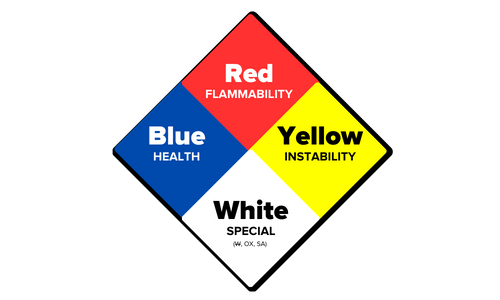
- Health (blue):
- Normal: 0
- Slightly Hazardous: 1
- Hazardous: 2
- Extreme Danger: 3
- Deadly: 4
- Fire (red):
- Will not burn: 0
- Above 200 Degrees F: 1
- Below 200 Degrees F: 2,
- Below 100 Degrees F: 3
- Below 73 degrees F: 4
- Specific (white):
- Use No Water
- Radiation Hazard
- Oxidizer
- Corrosive
- Alkali
- Acid
- Instability (yellow):
- Stable: 0
- Unstable If Heated: 1
- Violent Chemical Change: 2
- Shock & Heat May Detonate: 3
- May Detonate: 4
What Is a Fire Protection System?
A fire protection system is a critical part of an effective fire protection strategy. Fire protection systems help protect people and reduce structural and asset damage. This goes beyond a building or facility itself, and includes everything inside of it–even non-tangible assets like systems and data.
Some key components of common fire protection systems include:
- Fire alarms, smoke detectors, and emergency notification systems
- Sprinklers and other suppression devices such as CO2 or foam
- Fire extinguishers
- Fire-resistant or fire-proof building materials (doors, walls, etc.)
There are two primary types of fire protection systems: passive and active. Together, these two systems help mitigate fire hazards and enhance safety, regardless of setting or environment.
The Differences Between Fire Protection, Fire Prevention, and Fire Suppression
The terms fire protection, fire prevention, and fire suppression are often used interchangeably, but they’re not the same. All three are important in developing a comprehensive fire safety strategy, though.
Fire protection is designed to stop a fire and minimize fire-related damage. Fire prevention is proactive and encompasses steps to prevent fires while also decreasing hazards and potential fire impact. Fire suppression is about putting out a fire once it ignites.
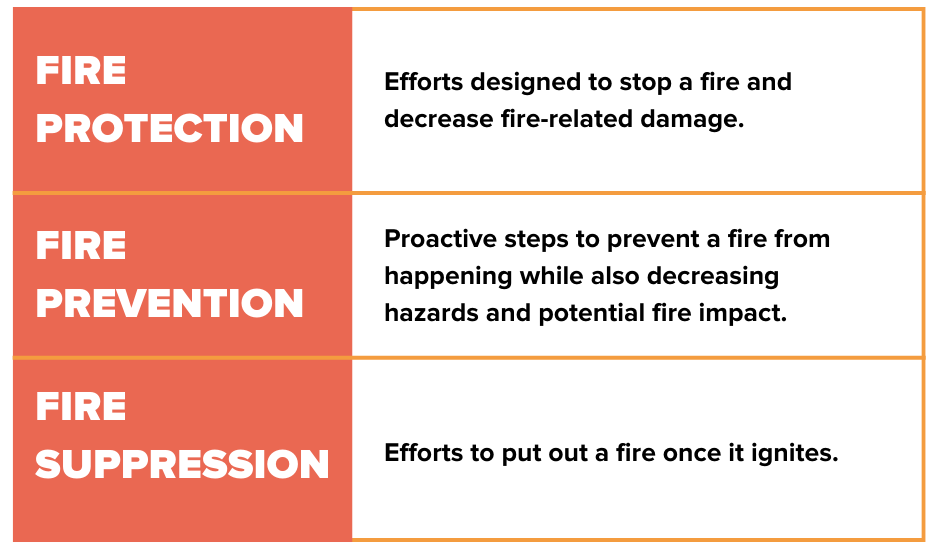
What Is Fire Prevention?
The NFPA defines fire prevention as “measures directed toward avoiding the inception of fire.” Essentially, fire protection focuses on ensuring the three components of the fire triangle don’t intersect and create the perfect conditions for a fire to start.
Some examples of fire prevention include:
- Conducting a fire safety risk assessment
- Installing smoke alarms and fire alarm systems
- Establishing exit routes with well-marked signage
- Conducting routine inspections and maintenance
- Conducting employee education and training
- Installing fire extinguishers
- Establishing properly marked storage areas for combustible, flammable, and hazardous materials
- Removing and properly storing flammable and combustible liquids and materials
What Is Fire Suppression?
Fire suppression is about controlling, containing, and putting fires out as quickly as possible. Fire suppression systems are generally activated when they detect a fire, heat, or smoke. There are several types of fire suppression systems that use everything from water to dry chemicals, gasses, foam, and other suppressant materials that starve the fire of heat, oxygen, and/or fuel.
Every fire suppression system has a specific purpose and uses a specialized method to fight fires. Some fire suppression systems include:
- Fire sprinklers consist of a network of pipes, sprinkler heads, and valves designed to release water when exposed to a specific high temperature, generally around 135-165°F. These systems suppress or control fires by dousing flames and cooling the surrounding area. They are effective for protecting all types of structures, from residential homes to large commercial buildings.When a fire creates enough heat for system activation, a specific sprinkler head will open and release water directly onto the fire. Most fire sprinkler systems are designed to activate only the heads in the immediate vicinity of the fire to minimize water damage in other areas.
- Clean agent fire suppression uses specialized gasses or other chemicals to suppress fires without damaging assets or sensitive equipment. These systems are often used to protect environments with expensive electronics, data centers, archives, and other areas where water damage would cause greater harm.These systems release the chosen agent into the protected area, displacing oxygen and interrupting combustion. This starves the fire of oxygen and extinguishes it without leaving residue or causing collateral damage.
- Fire suppression foam combines with water to create a solution that blankets and suppresses fire. Foam suppressants are usually either aqueous film-forming foam (AFFF) or alcohol-resistant aqueous film-forming foam (AR-AFFF). These systems are used to extinguish flammable liquids, such as oil, gasoline, or chemical spills in industrial settings, warehouses, or fuel storage areas.Foam systems deliver foam to a fire surface and form a thick layer to separate fire from oxygen, which prevents the release of flammable vapors. It also cools the flames to facilitate suppression.
- Carbon dioxide (CO2) fire suppression uses CO2 gas to displace oxygen and suffocate the fire. These systems are often used in areas with electrical equipment, control rooms, and flammable liquid storage.When the CO2 system detects a fire, it releases a predetermined amount of CO2 gas into the space, reducing oxygen concentration and inhibiting combustion, thereby extinguishing the fire.
- Water mist fire suppression disperses fine water droplets into the air, creating a mist to cool the fire, displace oxygen, and suppress flames. These versatile systems are often used in commercial buildings and industrial facilities.Water mist systems use high-pressure pumps to create a mist to absorb a fire’s heat and reduce the temperature. It also reduces radiant heat to help control and extinguish the fire.
Fire Inspections Are the Heart & Soul of Fire Protection
Fire protection consultants, contractors, and technicians are the driving force in building effective fire protection and fire safety plans — the heart and soul of which is the humble fire inspection. But if you’re bogged down maintaining pen & paper inspection reports or tediously planning recurring inspections by system and timeframe, you may find yourself scrambling when it comes time to conduct an inspection.
With Inspect Point, spend less time and energy on the tedious, administrative hassles of business so you can have more time to focus on what matters — conducting comprehensive and thorough inspections to reduce fire risk.
Within a single platform, Inspect Point helps you effectively manage your entire workflow from start to finish while ensuring you always meet industry compliance standards.
- Focus on fire protection
- Increase efficiencies
- Decrease expenses
- Streamline operations
Ready to take your inspection to the next level? Book a demo today to learn more.
Common Fire Protection Questions
What is a fire protection engineer?
A fire protection engineer (FPE), according to the Society of Fire Protection Engineers (SFPE), is a professional trained to 1) identify fire-related risks and 2) outline ways to reduce risk while 3) determining ways to mitigate, detect, control, and suppress fires. Fire protection engineers are not firefighters, although a firefighter could certainly become an FPE. FPEs are similar to other engineers in that they use the principles of science and engineering to protect people, structures, and the environment from fire hazards.
Fire protection engineers may find careers as fire investigators, consultants, researchers, fire system manufacturers, fire insurance professionals, facility managers, or in government or private businesses. In addition to analyzing fire hazards and mitigation planning, FPEs may also conduct post-fire investigations and conduct analysis of those fires. Learn more here.
What is a certified fire protection specialist (CFPS)?
A certified fire protection specialist (CFPS) is a credential awarded to fire industry professionals who successfully demonstrate competency in curtailing physical and financial fire losses. The NFPA oversees the program and certification testing. Once awarded the designation, a CFPS must renew annually with continuous education credits, and undergo a recertification process every three years.
What is fire protection software?
Fire protection software is a software solution that enables fire protection professionals to streamline, automate, and manage their workflows, including tasks likes scheduling, billing, invoicing, conducting inspections, tracking work orders, creating proposals, and managing customer relationships. Using a fire protection platform like Inspect Point, a fire industry professional can:
- Decrease the amount of paperwork they have to juggle
- Conduct inspections from a mobile device even without an internet connection
- Automate manual, repetitive tasks
- Track and bill completed work
- Create service proposals on site
- Effectively manage recurring inspections with an easy-to-understand scheduling system
- Integrate workflows with other operational tools such as QuickBooks
- Get end-to-end deficiency visibility
- Collect critical business data with reports and analytics for better decision-making
What are some best practices for fire protection at your business?
Here are some common best practices for fire protection:
- Conduct thorough fire risk assessments
- Identify potential fire hazards
- Evaluate fire hazard impact
- Create plans to mitigate fire risk
- Implement and manage plans
- Create a routine maintenance schedule for all fire protection systems, equipment, and devices
- Regularly inspect fire alarms, sprinkler systems, fire extinguishers, emergency lighting, and other fire protection systems to ensure they are in working condition
- Educate occupants and employees about fire safety protocols, evacuation procedures, and how to use fire safety equipment
- Conduct regular fire drills and evaluate escape plans and routes
What’s a fire safety inspection?
A fire safety inspection is a process that evaluates potential fire hazards to ensure proper procedures and precautions are in place to reduce the likelihood and impact of a fire. Depending on location or industry, fire inspectors have varying requirements to ensure structures meet compliance and other fire safety standards. That includes everything from the size of a structure and how it’s constructed to what it’s used for, what’s inside, and how many occupants there are.
Some key things a fire inspector might check:
- Proper storage and marking of flammable and combustible materials
- Blocked exits
- Sprinkler systems
- Fire extinguishers, smoke alarms, and fire notification systems
- Well-marked and clearly-lit evacuation routes and exits
- Implementation of safety and evacuation plans
- Issues with electrical wiring
- Improper use of extension cords or similar devices
- Fire doors or similar passive fire protection measures
- Review of fire suppression systems
- Proper equipment installation, maintenance logs, and repair documentation
- Employee/occupant education and training
What is a fire safety plan?
A fire safety plan documents the policies, processes, and procedures related to fire hazard identification, risk reduction, evacuation, notifications, alerts, and response. Every occupant of a building or facility employee should be familiar with the fire safety plan, including through routine training and drills. Building owners or facility managers must ensure all stakeholders have basic knowledge of approved fire suppression, mitigation, and containment processes.
What’s included in a business fire safety plan?
While every business will have a unique plan based on several factors including size, location, and industry, most business fire safety plans contain:
- Emergency evacuation procedures, plans, and routes
- Fire detection systems
- Fire alarm and notification systems
- Fire protection equipment
- Fire prevention equipment
- Fire suppression equipment
- Hazard identification, impact, and mitigation strategies
- Building/structure details (use, construction, layout, floor plans, occupant numbers, and locations)
- Roles, tasks, contact information, and communication plans and methods
- Internal and external response plans
- Training, education, and drills
“Inspect Point helps us significantly improve our operational efficiency. This powerful tool allows us to automate previously time-consuming and tedious tasks, increasing productivity. With the reduction in manual work, we can now allocate more resources to protect our clients better. Inspect Point has been instrumental in streamlining our processes, enabling us to provide a higher level of service and ensuring the safety of our clients.”
Inspect Point Is Your All-in-One Fire Protection Workflow Management Solution
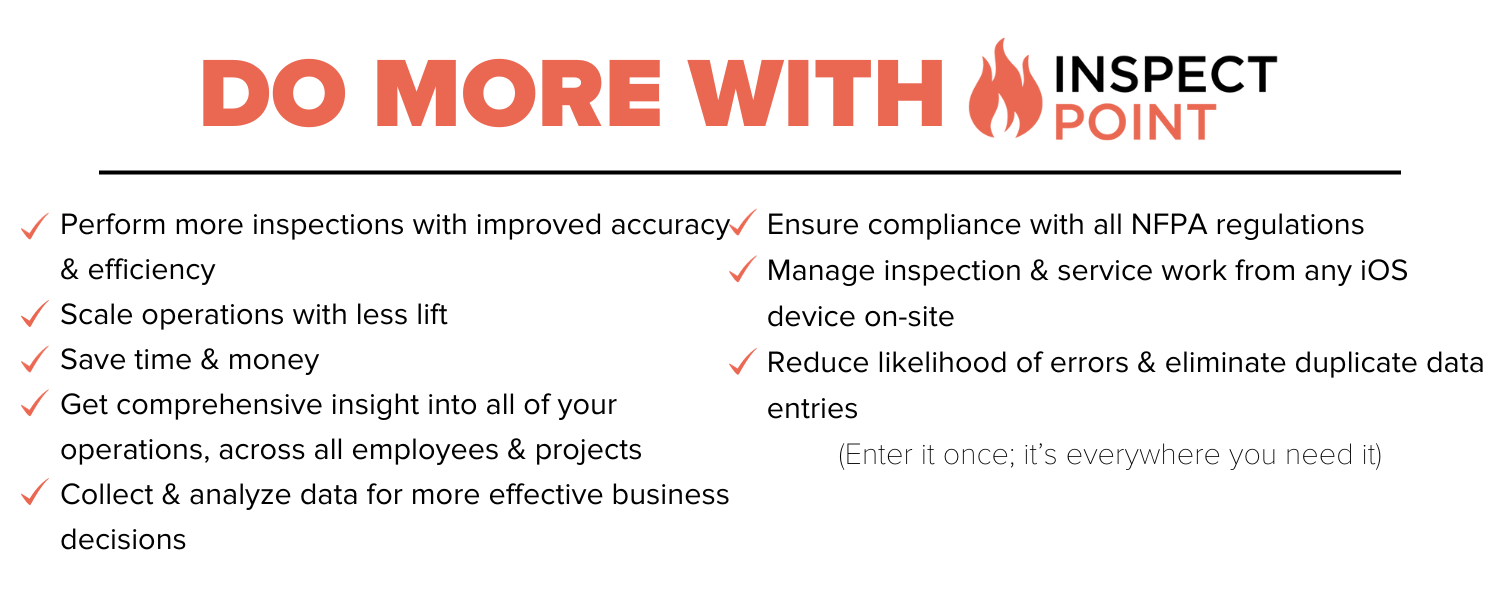
Understanding Fire Protection Regulations
Fire safety standards and regulations vary based on industry, location, and other criteria; however, in general, these guidelines are designed to minimize the likelihood of a fire, decrease potential injuries, save lives, and reduce fire impact. OSHA has a set of standards for all workplaces. There are also industry, local, regional, state, and federal fire protection regulations and fire codes. It is important to work with a licensed fire protection professional that is well-versed with the codes set by your authority having jurisdiction (AHJ).
What are some common fire safety code violations?
Local, state, and federal regulations guide fire safety codes. Here are some common violations:
- Having no (or non-functioning) smoke detectors or fire alarms
- Not designating or marking exit routes
- Blocking exits
- Locking fire exit doors
- No emergency lighting
- No (or expired) fire extinguishers
- Wiring issues
- Improper use of extension cords
- Improper storage of flammable or combustible materials
- Improper documentation or records
- Tripping hazards
- Failure to maintain fire safety equipment
What is NFPA?
One of the most well-known agencies that governs fire codes and standards is the National Fire Protection Association (NFPA). NFPA oversees more than 300 industry-recognized fire safety standards. It is a nonprofit that’s been around since 1896 with a mission to eliminate fire-related injuries, deaths, and property and economic losses. NFPA codes and standards are designed to minimize the likelihood and impact of fires and fire-related risks. More than 260 technical committees administer NFPA standards around the world. Codes are generally legal requirements at the state, local, or industry level, whereas standards are considered best practices.
What are NFPA standards?
Of the 300 fire codes and standards NFPA oversees, the core is the Fire Code, known as NFPA 1, dating back to the 1800s. The code became the baseline for other fire industry best practices. The Fire Code is generally updated every few years; the most current edition is from 2021.
The nearly 750-page document references some key NFPA codes and addresses important topics such as inspections, fire investigations, fire protection systems, fire safety education, fire department operations, fire hazards, permit requirements, and other regulations and controls. The code’s purpose is to suggest minimum requirements for fire safety, life safety, and property protection against hazards, explosions, and other dangerous conditions. It has several goals and objectives covering safety from fire, safety for building use, safety from hazardous materials, property protections, and public welfare.
While there is relevance and importance for all of the NFPA codes, these are most commonly referenced:
- NFPA 10: Standard for Portable Fire Extinguishers
- NFPA 12: Standards of Carbon Dioxide Extinguishing Systems
- Standard for Sprinkler System Installation
- NFPA 20: Standards for Stationary Pump and Fire Protection Systems
- NFPA 25: Standards for Inspection, Testing, and Maintenance of Water-Based Protections
- NFPA 70: The National Electric Code
- NFPA 70E: The Standard for Electric Safety in the Workplace
- NFPA 72: National Code for Fire Alarm and Signaling Systems
- NFPA 101: Life Safety Code
- NFPA 921: A Guide for Fire and Explosion Investigations
- NFPA 5000: Building Construction and Safety Code
The NFPA has an online code finder to simplify searches for which codes are applicable around the world. In the U.S., the database is broken down by states and includes statewide, as well as some key metropolitan, standards and codes.
You can find a full list of NFPA codes and details here.
What are UL-C Standards?
Similar to NFPA, in Canada, UL-C Standards provide guidance for fire protection and fire safety to help reduce fire risks, improve protection, and better understand fire protection standards. The Standards Council of Canada accredits UL-C Standards, which includes more than 1,500 standards. In the United States, the American National Standards Institute (ANSI) accredits UL Standards as well. UL Standards are designed to assess products; test components, materials, systems, and performance; and evaluate environmentally sustainable products, renewable energies, food and water products, recycling systems, and other innovative technologies.
The standards cover everything from fire-resistant products, systems, and designs to fire safety code authorities and fire alarms to fire suppression systems and fire doors to flammability testing, fire ratings, and more.
For more information about ULC Standards, visit UL’s website.
The Fire Protection Podcast
The fire protection industry is constantly changing and so are related codes, standards, equipment, features, and more. There’s a lot of reading and research to do. It’s increasingly hard to keep up, especially for fire professionals constantly on the go.
There’s good news, however. The subject matter experts at Inspect Point are keeping pace with everything so you don’t have to. And, you don’t have to scroll across pages of content for the latest updates.
Check out The Fire Protection Podcast, hosted by Inspect Point co-founder Drew Slocum. It covers everything from innovations in technology to equipment such as fire alarms, sprinklers, suppression systems, and extinguishers, to regulations, life safety best practices, and more.
Each episode tackles pressing industry topics and includes thoughtful conversations with industry professionals and thought leaders.
Here are some highlights of recent episodes:
- The Future of Fire Alarm Technology
- With New Regulations, Where Do Foam, HFCs, and 3M™ Novec 1230 Go From Here?
- Fire Sprinkler Antifreeze NFPA Changes with Sean Pearce of Lubrizol
- State of Pre-Engineered Systems with Jamie Knowles
You can find The Fire Protection Podcast on all of your favorite podcast apps like Apple Podcasts, Google Podcasts, Spotify, Stitcher, and TuneIn. Click here to listen now.
Inspect Point Works Hard So You Don’t Have To
From inspection to collection, Inspect Point has everything fire protection professionals need to do their jobs faster, more efficiently, and with more accuracy than ever before — all in a single platform.
With Inspect Point, you can manage your entire fire protection workflow with ease.

See Inspect Point in action today!
Book a Demo